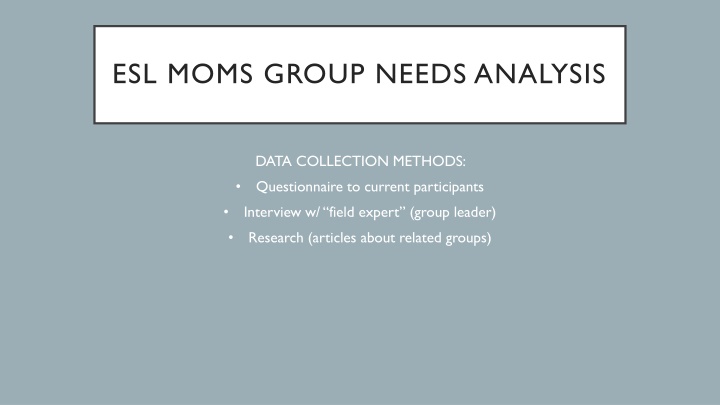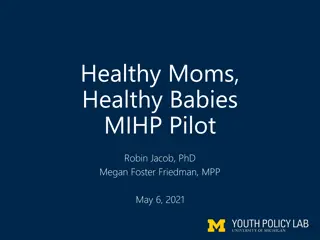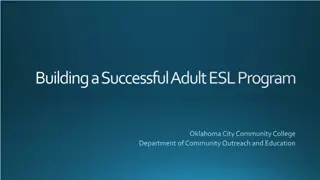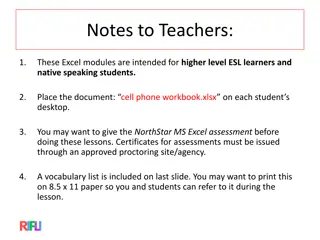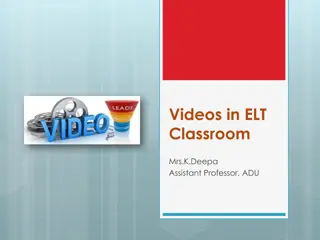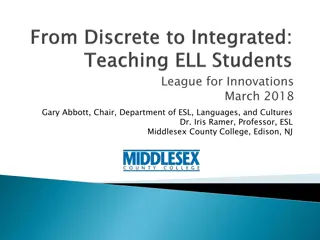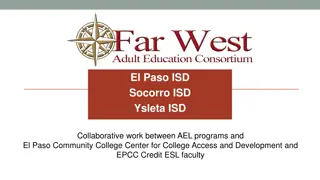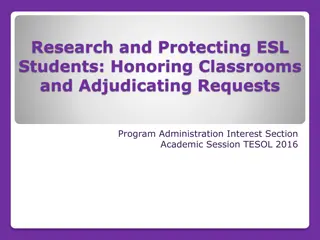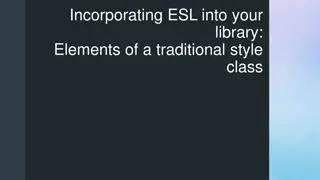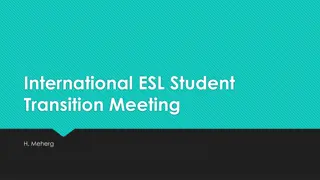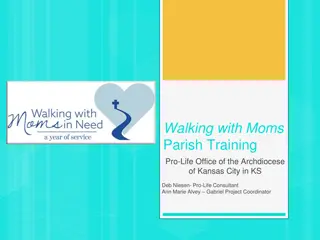ESL Moms Group Needs Analysis: Data Collection Methods and Insights
Conducting a needs analysis for an ESL Moms group involves various data collection methods such as questionnaires, interviews with the group leader, and research on related groups. The analysis covers participants' personal information, English language proficiency, group history, purposes for attending, employment backgrounds, classroom expectations, family life, personal interests, and socialization preferences. Insights reveal the significance of English proficiency for employment, socialization, cultural integration, parenting, and personal interests within the group.
Download Presentation

Please find below an Image/Link to download the presentation.
The content on the website is provided AS IS for your information and personal use only. It may not be sold, licensed, or shared on other websites without obtaining consent from the author.If you encounter any issues during the download, it is possible that the publisher has removed the file from their server.
You are allowed to download the files provided on this website for personal or commercial use, subject to the condition that they are used lawfully. All files are the property of their respective owners.
The content on the website is provided AS IS for your information and personal use only. It may not be sold, licensed, or shared on other websites without obtaining consent from the author.
E N D
Presentation Transcript
ESL MOMS GROUP NEEDS ANALYSIS DATA COLLECTION METHODS: Questionnaire to current participants Interview w/ field expert (group leader) Research (articles about related groups)
QUESTIONNAIRE Participants: Question types: 12 current participants of the ESL Moms group #1-8: Personal information (family life, education, relationship status, etc.) Method: #9-11: Establishing current proficiency in English language and American culture 1. Administer in person during meeting Only 4 participants in attendance 12: Personal Interests 2. Promote electronic submission through email and Facebook 13-14: History in the group 15-23: Purpose/Expectations for attending Collected 8 more questionnaires
ENGLISH LANGUAGE WHY? Purpose for Attending Group EMPLOYMENT 100% of the group higher education >90% of the group employed in home country Only 4 members currently employed 0% in the same position 100% self-employed 10/12 participants plan to stay in the U.S. permanently Lanugage Socialization Culture Parenting ALL FOUR PURPOSES ENTAIL ENGLISH PROFICIENCY
CLASSROOM EXPECTATIONS CLASSROOM PREFERENCES IMPLICATIONS 1. High interaction (social purpose) 1. Variety of groupings during meeting time 2. 7/12 voted for not doing homework for the group 2. Homework with no washback 3. 7/12 use the Facebook page 3. Social media = keep it social! Most want to see content about upcoming activities 4. Improve speaking for social interaction? Build lexis with casual speech elements 4. English skills: speaking skills received most votes
ENGLISH LANGUAGE WHAT? RELATIONSHIPS FAMILY LIFE Children's Ages 11/12 currently married Most participants have been in the group for >1 year IMPLICATIONS Parenting content focus: elementary children Relationship content focus: marriage Change content yearly Baby-toddler Middle School age Preschool age High school age Elementary age
ENGLISH LANGUAGE WHAT? PERSONAL INTERESTS & SOCIALIZATION WANT TO LEARN: Cooking (4) Parenting(4) Leisure (2) Entertaining (2) Style (1) Lifestyle Holidays (5) Weddings (2) Celebrations IMPLICATIONS: Tailor content to interests of group for increased motivation Treat topics as specializations, gathering target language from specialized texts Socialization (5) Education (2) Language (2)
POSITIVE & NEGATIVE FEEDBACK Favorite Thing About Group Suggestions for Change Socialization Content Location Teachers Nothing Content Interaction Time IMPLICATIONS: include more variation in grouping, change content focus more frequently to interest and engage all participants
COLLABORATION WITH GROUP LEADER Multi-media approach: using music, books, modern media (memes) to incorporate vocabulary and cultural content Social Language: teach idioms and phrasal verbs related to lesson themes, include vocabulary lists & emerging vocabulary Current Events content: use discussion of current events to increase social interaction and cultural knowledge
OTHER RESEARCH Motivations for Immigrant parents: Kids assimilating to American culture faster due to quicker language acquisition (Monica Campbell in PRI) Desire to help children in school (Campbell) General parenting tasks such as doctor s appointments (Welcoming Refugees) Study (Michael Walsh in Hartford Courant) Connect to community (Walsh) Self-improvement (acquiring driver s license, jobs) (Walsh)
COURSE DESIGN SUGGESTIONS 1. Grow with Mothers Course sequence = fundamental parenting + independence for moms 2. Facilitate Friendships Classroom management more grouping variety Social media alert local activities (growing friendships outside of group) 3. Language Focus Learner Autonomy teaching skills, providing tools (homework) to expand outside of class Social speaking elements 4. Content Geared toward married moms with elementary aged children Give learners control choose content related to their personal interests
